In the present digital marketing, where trends come and go, one strategy has stood the test of time and continues to be a cornerstone of online success for businesses – corporate blogging. In this article, we discuss:
- What is Corporate Blogging?
- Different Types of Corporate Blogs
- Corporate Blogging Best Practises
- Setting Up Your Corporate Blog
- How to Measure the Success of Your Corporate Blog
- Advanced Strategies for Corporate Blogging
- How to Avoid Common Pitfalls in Corporate Blogging
- Future Trends and Innovations
- Conclusion
What is Corporate Blogging?

Now you might be wondering “What is a corporate blog?”. Here’s the answer!
Definition
A corporate blog is a place where a business or an organization creates content and discusses things with its target audience, potential customers, investors, and any other parties out there who are interested in the business/organization itself.
Benefits of Corporate Blogging
At its core, corporate blogging involves the creation and publication of content on a company-owned blog to engage with customers, prospects, and industry stakeholders. Here are the key benefits of Corporate Blogging.
Offer businesses a unique opportunity to showcase their expertise: Unlike traditional marketing channels, such as advertisements or press releases, corporate blogs offer businesses a unique opportunity to showcase their expertise, share relevant industry news, and address common pain points faced by their audience.
Helps to build trust and credibility: The content shared on corporate blogs is often tailored to address the interests and needs of the company's target audience, providing them with relevant and valuable information that helps to build trust and credibility over time.
Fosters meaningful connections with your target audience: Builds potential relationships with customers, prospects, and other stakeholders.
Enhances brand visibility
Drives website traffic
Different Types of Corporate Blogs

Corporate Blogging is a vast area as there is no general format for company blogging/ business blogging. In other words, one company’s blogging format is totally different from another company’s blogging format. Thus, the phrase “corporate blogs” is somewhat misleading when thinking of their types. Although most companies and individuals have similar intentions with their internet blogs, the corporate blog has quite a few varieties. Such as,
1. Campaign Blogs
Campaign Blogs are a type of corporate blog that is operated for certain advertising campaigns. They are often tied to new product or service launches. These types of corporate blogs are operated only for a limited period of time. However, here is the controversial point. Though some businesses create campaign blogs for these purposes, some other business might use their already existing organic traffic blogs, news blogs, or service blogs to fulfill the same purpose covered by campaign blogs.
For example, let's take the scenario where your business is launching a completely new product. You may write about the advantages of the product for customers, how it relieves some of their problems, and when it will be released on your already-existing blog. This makes it easier for you to market your new product to the audience you already have. After the campaign ends, you can get back to writing on your blog normally.
2. News Blogs
Businesses/ organizations use news blogs to deliver the latest news about their business/organization to their customers, investors, and any other interested parties out there. These blogs contain information like product releases, company announcements, awards, speeches, CSR projects, collaborations, partnerships, and any other information the company might want to relay to its readers. However, news blogs do not help massively towards gaining potential customers but attract investors or partnerships if interested.
3. Customer Relationship Blog
Companies/organizations use these customer relationship corporate blogs to build a community by sharing some commonalities, who feel a unique bond with the organization. For instance, conducting online product reviews can benefit greatly from this approach.
4. Organic Traffic Blogs
The organic traffic blogs specifically target terms or keywords that users may enter into a search engine. Businesses benefit from increased organic traffic as a result. This is one of the most widely used blogs by companies and organizations. That's because it offers numerous advantages, such as cultivating relationships with the audience and turning readers into paying clients. Businesses are providing content that their audience wants to read by focusing on information that people are searching for. When a firm effectively responds to a reader's query or assists in resolving their issue, the reader is more satisfied and is more likely to look into the company further. Although it takes time to set up and maintain an organic traffic blog, the returns are remarkable, especially when a knowledgeable team is involved.
Usually, SaaS businesses run these blogs as SaaS blogs for their SaaS marketing, startups run these blogs as startup blogs and other organizations run these blogs as their company blog.
5. Thought Leadership Blogs
Businesses publish opinion-driven pieces on thought leadership blogs to showcase their subject matter or industry knowledge. By doing this, they can raise the authority of their brand, which will help them forge closer bonds with their audience and foster more customer loyalty.
It can be quite helpful for a firm if it has a thought leader who can assist in focusing and driving this type of blog. However, because the articles depend on the thought leader's insights and knowledge to be effective, it frequently takes a lot of work from them. A thought leader is still needed to spearhead the effort, even if you can get the assistance of more independent authors and organizations.
Read More: Thought Leadership Content
6. Service Blogs
Via these blogs, companies companies provide in-depth information about their services and products to their customers and customers-to-be. These can be a tutorial article on how to use their products easily.
7. Topic Blogs
This version is quite inclusive with only one restriction: the blog needs to be focused on a specific subject. To position the business as an authority in a field and sway public opinion, a themed blog is especially helpful.
Corporate Blogging Best Practises
In any type of industry, following best practices plays a huge part when working towards success. When it comes to corporate blogging, following corporate blogging best practices is considered a good move. Let’s look into corporate blogging best practices. These best practices are well explained from A-Z: from starting corporate blogging to maintaining corporate blogs.
Setting Up Your Corporate Blog
Before diving into the world of corporate blogging, it's essential to lay a solid foundation. First of all, to set up or start a corporate blog you must select the right blogging platform.
Selecting the right blogging platform
Start looking for a blogging platform that aligns with your corporate blogging goals and technical requirements. There are lots of blogging platforms out there for you to choose from. Focus on what each blogging platform or CMS(content management system) offers you and how well their features align with your blogging requirements. For example, Hyvor Blogs, Ghost, Medium, Blogger, and more. We recommend you try Hyvor Blogs.
Here is detailed information about Hyvor Blogs that you might find the right choice for your blogging platform.
Hyvor Blogs
Hyvor Blogs is an all-in-one blogging platform that makes blogging very simple. With Hyvor Blogs you can start and publish your blog in a couple of minutes.
Here are the key features of Hyvor Blogs which makes it one of the good WordPress alternatives.
Simple, easy, and fast - Hyvor Blogs is designed to highly cache your blog and readily serve it to all your visitors. You don’t have to spend money on external plugins. Want to see how fast it is? This very blog is run on Hyvor Blogs. You can navigate between pages to see how fast it is. While you can purchase plugins, optimize theme code, and hire a developer to make other CMSs faster, why bother? Hyvor Blogs is super fast by default.
Multi-language support by default - You can add new languages to your blog as you prefer. You can start multi-language blogging using different languages and grow your audience. It is just a piece of cake.
Auto translation - No tedious tasks of translating blog posts into different languages. With just one click, you can translate your blog posts easily.
Host anywhere you like - can be hosted on the given free subdomain (on hyvorblogs.io), on your own custom domain, or in a subdirectory. If you have a web application (ex: Laravel), you can easily set up to host your blog on a sub-directory.
Powerful rich text editor - Hyvor Blogs’s carefully crafted rich text editor makes writing blog posts effortless. Add headings, blockquotes, images, embeds, code blocks, and more.
Customizable Themes - Raydo, Pela, Zing, and more. All of these themes are editable and completely free for anyone using Hyvor Blogs. You can make your own theme for your blog if default themes do not satisfy you.

Raydo, Hyvor Blogs latest theme Custom domains - You can set up your own custom domain blog, with no hidden costs, and no additional charges, just start blogging using a custom domain with few clicks. Learn More.
Right-to-left (RTL) languages supported - You can blog using RTL languages hassle-free.
Free commenting system - Hyvor Talk is completely FREE in Hyvor Blogs. So, you can have a commenting space on your blog at no cost. A blog without a commenting space is dull.
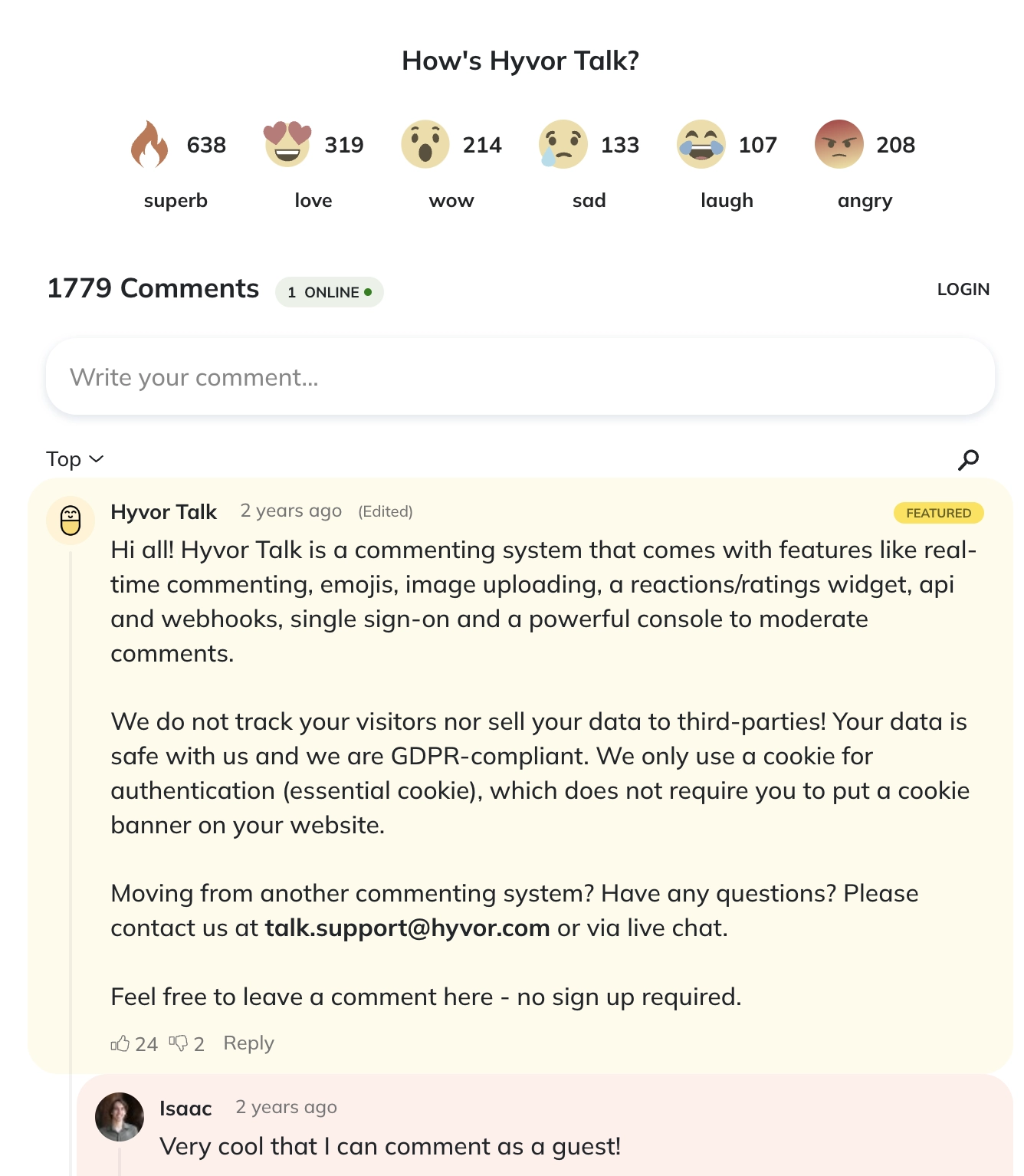
Real-time SEO analysis - This real-time SEO analyzer gives you suggestions to improve your post's SEO as you write. It checks for keyword usage, internal and external links, and more SEO-related factors.

GPT (AI) for content creation - Chat with GPT to generate content, blog post outlines, and more. GPT is integrated directly into the editor, making it easy to use generated content in your posts.
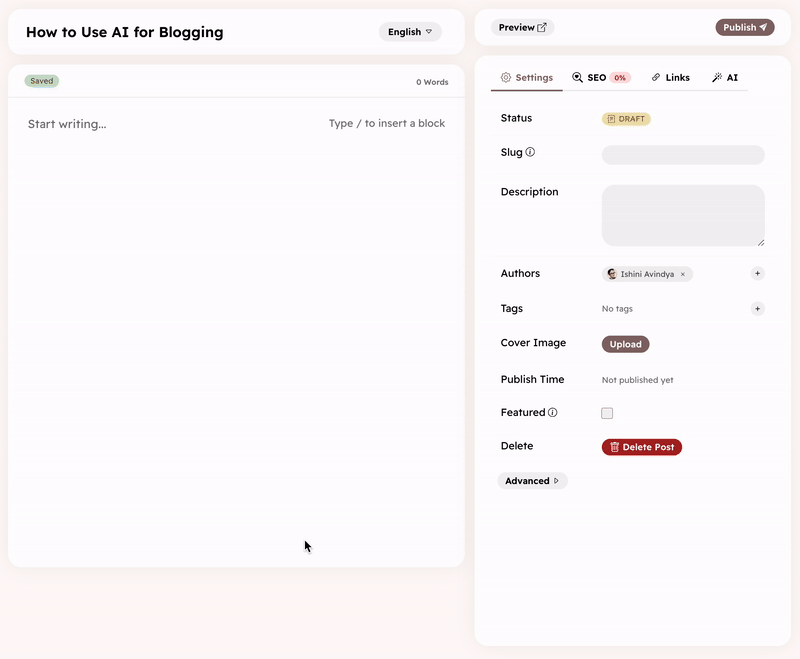
Broken link analyzer - Hyvor Blogs’s link analyzer checks for broken links in your posts as you write. It also runs a bi-weekly check on all your posts and notifies you via email if any links are broken.

In-built link analyzer by Hyvor Blogs Mobile friendly - You can blog from anywhere using any device. Even using your mobile.
Google Fonts, locally
Privacy protected
Complete control - HB does not inject ads, trackers, affiliate links, or paywalls into your blog. It's your blog - You decide everything!
Data Ownership - You own the content you write. You can export your content and move to another platform anytime.
User-friendly blog console - Easily manage your blog with a user-friendly blog console.
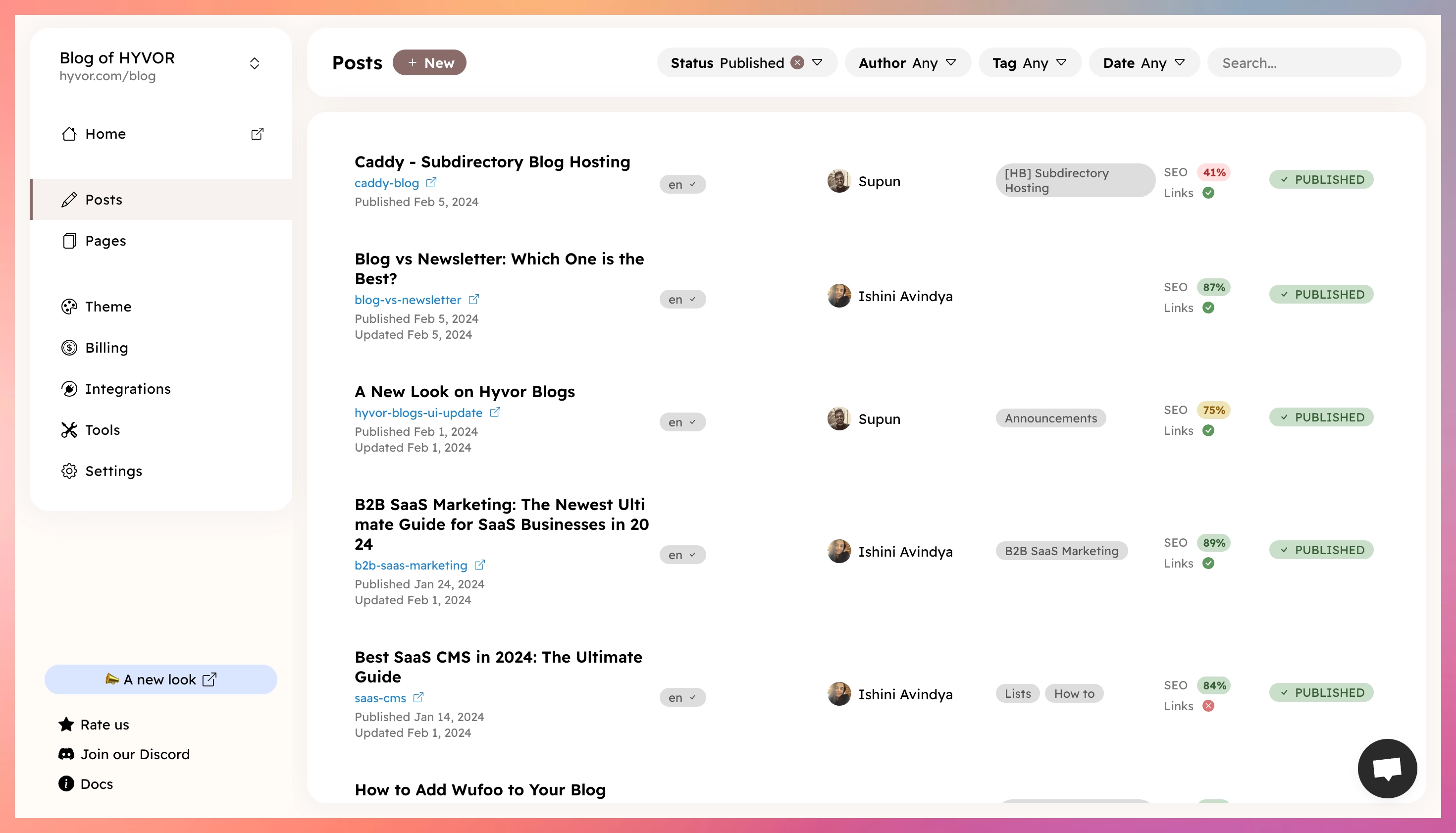
Hyvor Blogs console Team collaboration - Invite your team to work with you.
In-built SEO - All you need for technical SEO is in-built in HB
Easy to set up with essential tools
Sub-directory hosting - Host your blog at /blog of your web app: Cloudflare workers, Next.js, Laravel, Symfony
Excalidraw Integration - The famous drawing tool, Excalidraw, is now embedded within the image uploader to help you quickly draft a sketch as you write.
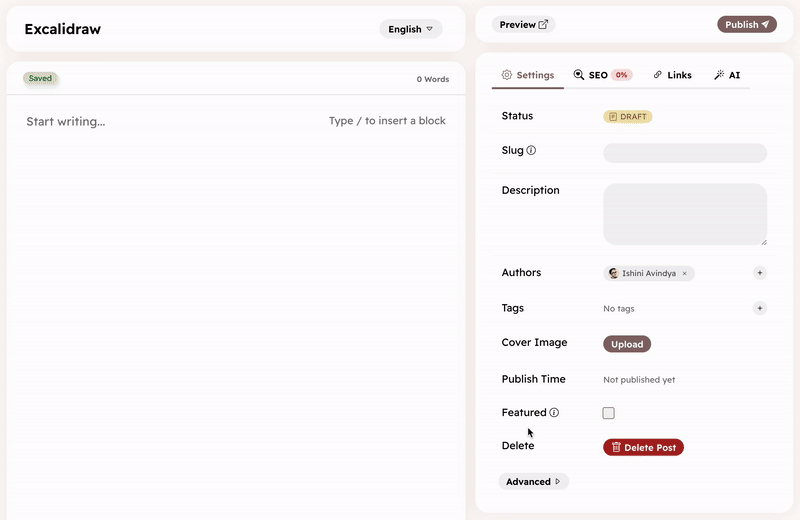
Plus, Hyvor Blogs is completely developer-friendly.
Data API - Access public data of your blog as JSON using our Data API. For example, you can use it to get the latest posts on your blog. The Data API makes Hyvor Blogs work as a headless CMS for an alternative front-end.
Delivery API - Delivery API allows you to host your blog within a subdirectory of your web applications, with the help of Webhooks.
Console API - This is the same API we use in the Console. Automate some of your administrative tasks, or you can even build your own console.
Webhooks - Ping a URL when something happens on your blog (ex: when a post is created).
Not only that but also HB supports web framework integrations such as Symfony, Laravel, etc.
Affordable Pricing - Hyvor Blogs pricing is based on the number of admin users (writers) on your blog and the total amount of Storage used. There are no feature limitations. See pricing for up-to-date information.
2 Users - $9/month
5 Users - $19/month
15 Users - $49/month
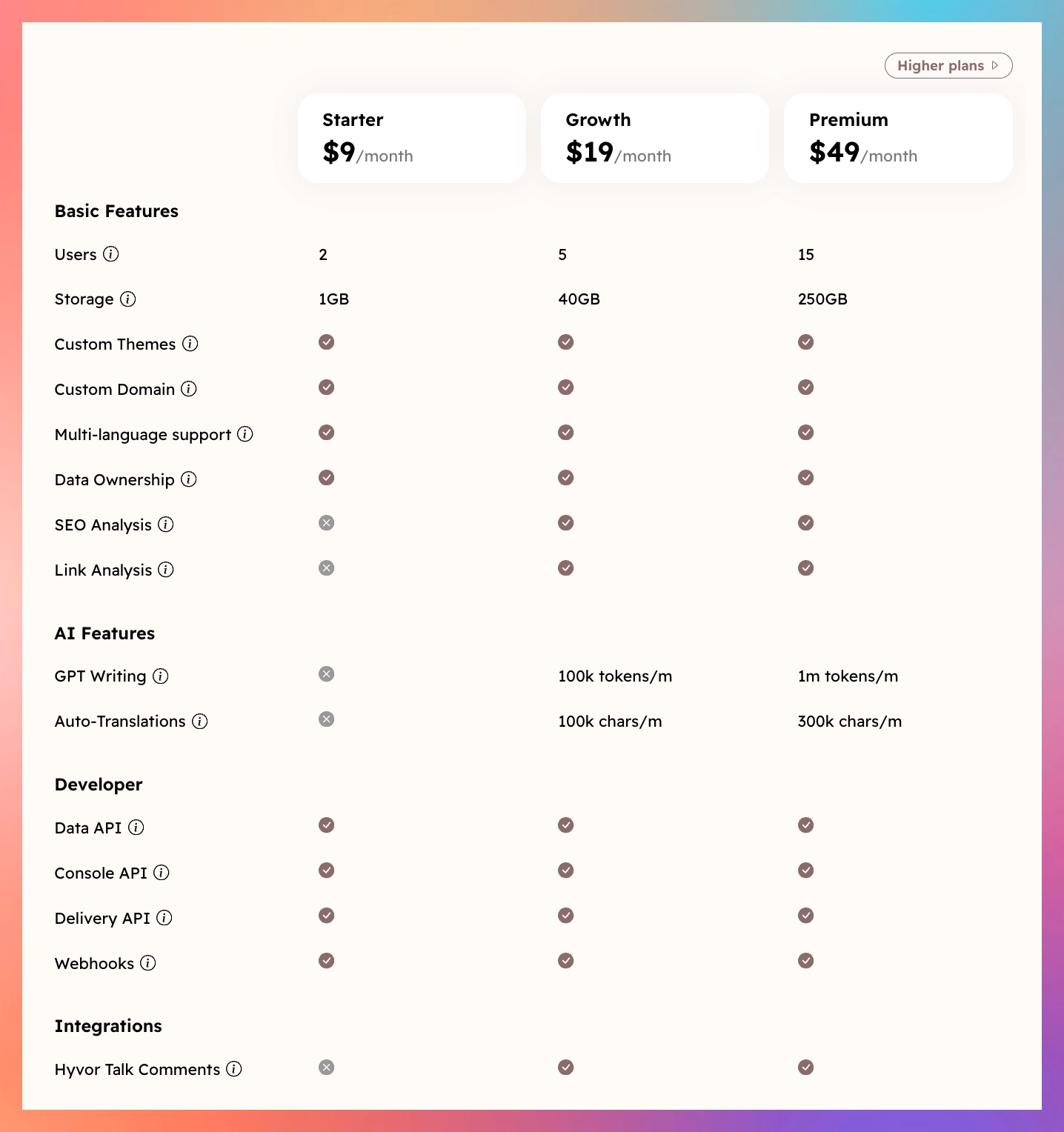
Hyvor Blogs Pricing 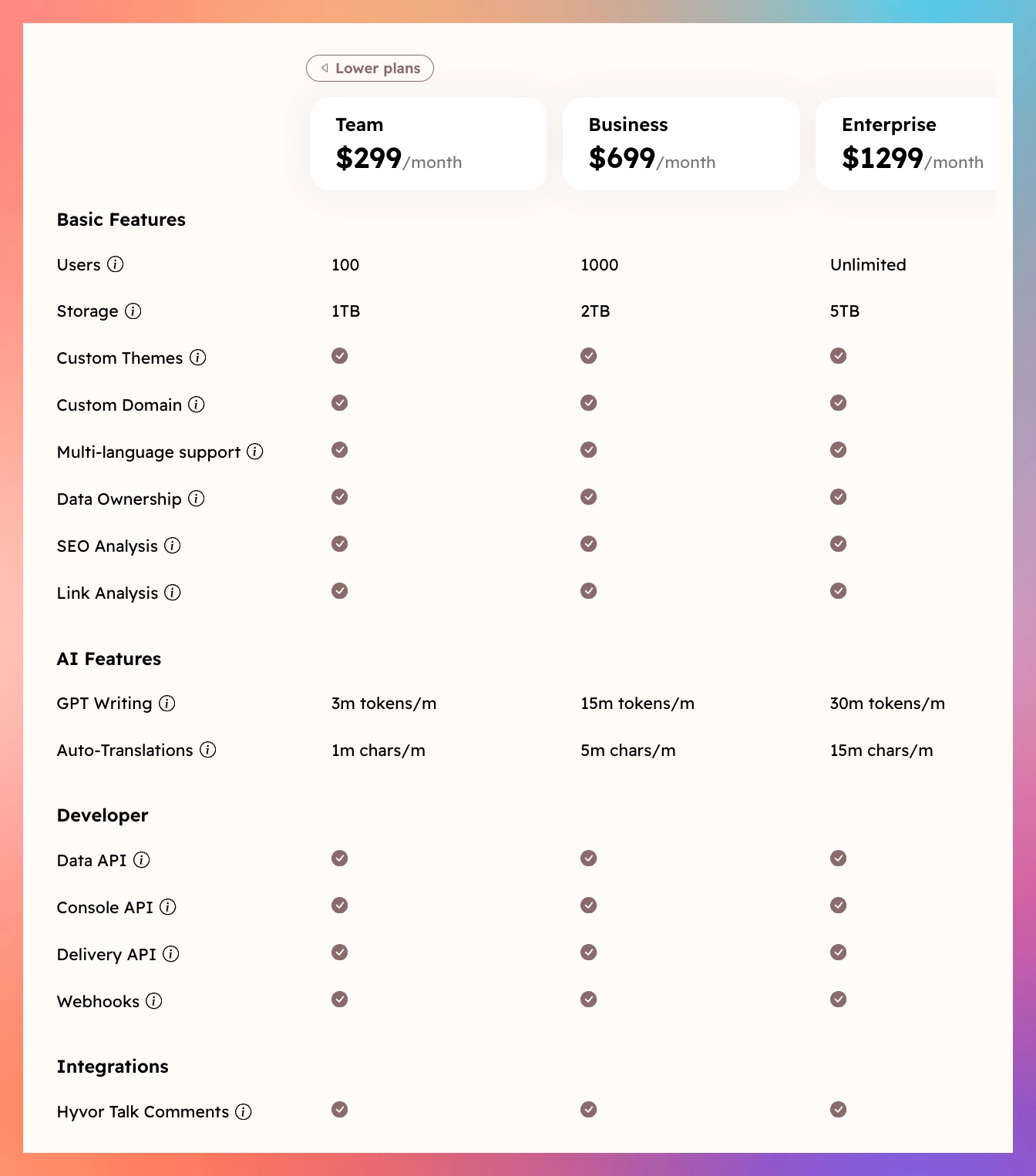
Hyvor Blogs Pricing Hyvor Blogs' pricing plan is more affordable and inclusive, with all features available on a single plan. This makes it a good option for users who want to blog freely without breaking the bank.
Once you've chosen a platform, the next thing you have to do is focus on designing your blog. When designing, make sure the design reflects your brand identity. From selecting color palettes and typography to incorporating your company logo, every aspect of your blog's design should be cohesive and representative of your brand.
Create Compelling Content

Any blog's success is determined by the quality of its material. And that’s a fact even when it comes to corporate blogging. To keep your audience interested and returning for more, you must offer content that is not only instructive but also appealing and relevant to their needs. Here are some tips for you to create compelling content for your corporate blog.
Know Your Audience: Understanding your target audience is the first step towards creating compelling content. To do that, first, you should put yourselves in the shoes of your audience. Think like a reader of your blog. Therefore you can analyze and understand your target audience's needs, pain areas, and preferences like a piece of cake.
This can be quite tricky if you are new to this task. But, no worries, following the steps mentioned in this article will get you there in no time. No hurries, take the time to research and analyze the demographics, interests, pain points, and preferences of your target audience. Make sure to take notes while the analysis is going on. Once you understand your target audience, take a look back at the notes you took while researching and analyzing. This will help you tailor your content to resonate with their needs and interests.
Address Their Needs and Pain Points: Once you have a clear understanding of your target users/audience, brainstorm topic ideas that directly address their needs, challenges, and pain points. In this stage, you will need the notes that you took when you were analyzing your target audience. Here again, you have to put yourselves in your audience's shoes. Think about the questions they may have, the problems they're trying to solve, or the goals they're trying to achieve.
The key secret to compelling content is your content should provide valuable insights, practical solutions, or actionable advice that helps them overcome obstacles and achieve their objectives. There are tools that you can get help for this: Ahrefs keyword explorer and content explorer, AnswerThePublic, etc.
Provide Value: Whether it's in the form of how-to guides, industry insights, best practices, case studies, or customer success stories, your content should offer tangible value to your audience. Strive to deliver content that educates, informs, inspires, or entertains your readers. Focus on providing actionable takeaways or unique perspectives that they can't find elsewhere. In other words, your blog, and your content must be UNIQUE!
Maintain Relevance: Keep every bit of your content relevant to your audience's interests and concerns. Always stay up-to-date with industry trends, news, and developments. Incorporate timely topics into your content calendar. Pay attention to feedback from your audience and adjust your content strategy accordingly to ensure that you're addressing their evolving needs and preferences.
While maintaining relevance, making your content up to date massively helps your SEO. Search engine crawlers love updated content.Be Authentic: Authenticity is key to building trust and credibility with your audience. Nobody loves reading unauthentic content. As a corporate blogger, you can share real-life experiences, insights, and perspectives that demonstrate your company/organization's expertise and authenticity. Avoid overly promotional or sales content. Readers quickly spot those and tend to move away. Instead, focus on building genuine connections with your audience through storytelling and transparency.
Use Engaging Formats: Do you love reading content written as long paragraphs and paragraphs? It’s getting quite boring, right? Using engaging formats in your content is one of the key methods to keep your audience with your corporate blog. For that, you can experiment with different content formats to keep your audience engaged: relevant engaging formats depend on each corporate blog. This could include images, videos, infographics, podcasts, webinars, quotes, callouts, interactive, animations, quizzes, or surveys. Mix and match these formats to cater to different learning styles and preferences and to keep your content fresh and dynamic.
Optimize for Readability: The other important check is to make sure your content is easy to read and digest. Long content reading exhaustion can be avoided by importing readability. When creating content use clear and concise language, break up long paragraphs with subheadings, bullet points, and numbered lists, and incorporate visuals such as images, charts, or diagrams to enhance readability and comprehension.
Encourage Interaction: Foster engagement and interaction with your audience by inviting them to leave comments, ask questions, give suggestions, start discussions, or share their own experiences and perspectives. This is an important method to keep your audience interacting with you, your blog, and other peer readers. This creates an environment where your audience can find much more insights from many other perspectives in addition to your blog. This makes them spend more time and feel the expertise of your corporate blog. Respond to the comments promptly and encourage dialogue and conversation (discussions) around your content. This not only helps to build a sense of community but also provides valuable feedback and insights for future content creation.
Following these tips will give you an outcome of creative and compelling content for your corporate blog.
Optimize for Search Engines
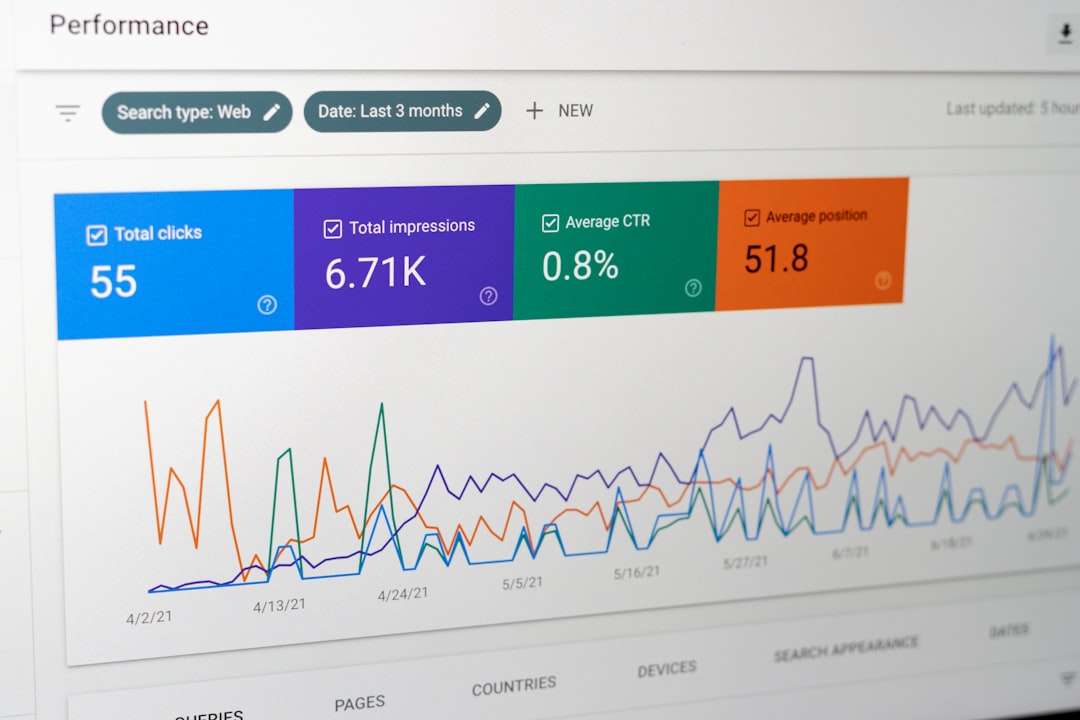
At this very present, getting your blog content discovered by your target audience is definitely a challenge with many competitors in your same sector out there. This difficulty will not be decreased in the future but only increase. This is where search engine optimization (SEO) comes in and rules. Thus, optimizing your corporate blog for search engines is essential for improving its visibility and attracting organic traffic from your target audience. Here's a deeper look into how you can effectively optimize your blog content for search engines:
Keyword Research: Before creating any type of content, start by conducting keyword research to identify the terms and phrases your target audience is using to search for information related to your industry, products, or services. Use keyword research tools like Ahref, Google Keyword Planner, SEMrush, or Moz Keyword Explorer to discover relevant keywords with high search volume and moderate competition. Then start creating content aiming at those keywords. If you are writing, choose a content editor that helps. you to keep track of target keywords while writing so that you do not have to pay much attention to keyword density and other keyword optimizations as the editor does that for you. If you choose Hyvor Blogs, the content editor of Hyvor Blogs will track all the necessary SEO keyword optimization for you. So, you can give your full attention to the quality of the content.
On-Page Optimization: Once you've identified your target keywords, incorporate them strategically into your blog posts. Place your primary keyword in the title tag, meta description, and URL of your blog post. Use variations of your target keyword throughout the content, including in headings, subheadings, and body paragraphs, image alt texts, and captions while ensuring that the content reads naturally and provides value to your readers.
Content Quality and Relevance: Search engines prioritize high-quality, relevant content that satisfies user intent. Focus on creating in-depth, informative, and engaging content that addresses specific search queries and provides valuable information to your audience. Aim to answer common questions, solve problems, or fulfill needs that your target audience may have, positioning your blog as a trusted resource within your industry.
Internal and External Linking: Create internal links within your blog posts to connect related content on your website. This not only helps users navigate your site but also distributes link equity and authority across your pages, improving overall site visibility. Additionally, earn backlinks from authoritative and relevant websites in your industry through guest blogging, outreach, or B2B partnerships. Quality backlinks signal to search engines that your content is credible and valuable, potentially boosting your rankings in SERPs. Hyvor Blogs checks all these internal and external links and gives you a full link analysis on each of your blog posts.
Mobile-Friendly Design: Ensure that your corporate blog is optimized for mobile devices, as mobile usability is a significant ranking factor for search engines. Use responsive design techniques to ensure that your blog content displays correctly and functions seamlessly across various screen sizes and devices. Doing this improves the user experience and improves your chances of ranking higher in mobile search results on the web. Hyvor Blogs is always mobile-friendly and takes care of mobile optimization.
Page Speed and Performance: Page speed and performance are critical factors for both user experience and search engine rankings. Optimize your blog's loading times by minimizing file sizes, leveraging browser caching, and optimizing images and multimedia content. Use tools like Google PageSpeed Insights or GTmetrix to identify and address performance issues that may be affecting your blog's speed.
Schema Markup: Implement schema markup on your blog posts to provide search engines with additional context about your content. Schema markup helps search engines understand the structure and meaning of your content, making it more likely to appear as rich snippets or enhanced search results in SERPs, which can improve click-through rates and visibility.
Regular Content Updates: Finally, maintain a consistent publishing schedule and regularly update your blog with fresh, relevant content. Search engines favor websites that regularly produce new content, so aim to publish blog posts on a consistent basis to keep your audience engaged and to signal to search engines that your site is active and authoritative.
By implementing these SEO best practices, you can optimize your corporate blog for search engines and improve its visibility, driving organic traffic and ultimately achieving your marketing objectives.
Promote Your Corporate Blog

Here’s the fact. Creating and publishing great content is only half the battle: the second half is ensuring that it reaches your target audience. There are many strategies you can use, in order to win this second half of the battle. Here are the best and proven strategies to promote your blog.
Social Media Promotion: Leverage the power of social media platforms to amplify your blog content and engage with your audience. Share your blog posts across your company's social media profiles, including platforms like Facebook, Twitter, LinkedIn, Instagram, and Pinterest. Tailor your messaging and visuals to each platform's audience and format, and use relevant hashtags to increase discoverability. Encourage your followers to like, comment, share, and engage with your posts to extend your reach even further.
Email Marketing Campaigns: Incorporate your blog content into your email marketing campaigns to reach your subscribers directly. Send out regular newsletters featuring highlights from your latest blog posts, along with enticing subject lines and compelling CTAs to drive traffic back to your blog. Segment your email list based on subscribers' interests and preferences to deliver personalized content that resonates with each audience segment.
Influencer Partnerships: Collaborate with influencers or industry experts in your niche to amplify your blog content and reach new audiences. Identify influencers whose audience aligns with your target market and reach out to them to propose collaboration opportunities, such as guest blogging, co-created content, or social media takeovers. Their endorsement and promotion of your blog content can significantly increase its visibility and credibility among their followers.
Industry Publications and Guest Blogging: Seek out opportunities to contribute guest posts to reputable industry publications or blogs within your niche. Write high-quality, informative articles that provide value to their audience while subtly promoting your brand and expertise. Include a brief author bio and link back to your corporate blog to drive traffic and establish your authority within the industry. Similarly, invite influential figures in your industry to contribute guest posts to your blog, thereby leveraging their expertise and audience reach to attract new visitors.
Cross-Promotion with Partners: Collaborate with other businesses or complementary brands in your industry to cross-promote each other's blog content. Identify potential partners with a similar target audience but non-competing products or services, and explore opportunities for mutual promotion, such as sharing each other's blog posts on social media, featuring guest posts on each other's blogs, or co-hosting webinars or events. Cross-promotion allows you to tap into each other's existing audiences and expand your reach organically.
Paid Promotion: Consider investing in paid promotion channels, such as social media advertising or sponsored content placements, to boost the visibility of your blog content. Allocate a portion of your marketing budget to targeted advertising campaigns that promote your blog posts to specific audience segments based on demographics, interests, or online behavior. Monitor the performance of your paid promotions and adjust your strategy as needed to optimize ROI (Return on Investment) and maximize results.
By implementing a comprehensive blog promotion strategy that leverages a mix of social media, email marketing, influencer partnerships, industry collaborations, and paid promotions, you can increase the visibility and reach of your corporate blog, attract more traffic, and ultimately achieve your marketing objectives.
How to Measure the Success of Your Corporate Blog

To gauge the effectiveness of your corporate blogging efforts, it's essential to track and analyze key performance indicators (KPIs). These may include website traffic, engagement metrics (such as likes, shares, and comments), conversion rates, and lead generation. By regularly monitoring your blog's performance and analyzing data insights, you can identify areas for improvement and refine your content strategy accordingly. Here's a detailed explanation of how you can effectively measure the success of your corporate blog:
Website Traffic: One of the most basic yet crucial metrics to track your corporate blog’s performance is website traffic. Monitor the total number of visitors to your blog over time, as well as the sources of traffic (e.g., organic search, social media, referrals). Analyze trends and patterns in traffic to identify periods of growth or decline and correlate them with specific content initiatives or promotional efforts.
Engagement Metrics: Assess the level of engagement with your blog content by tracking metrics such as likes, shares, comments, and time spent on the page. These metrics indicate how actively your audience is interacting with your content and can provide valuable insights into which topics resonate most with your readers. Pay attention to trends in engagement metrics to identify high-performing content and replicate its success.
Conversion Rates: Measure the effectiveness of your blog in driving desired actions or conversions, such as newsletter sign-ups, ebook downloads, or product purchases. Track conversion rates for specific call-to-action (CTA) elements within your blog posts and analyze which types of content or CTAs are most effective at converting visitors into leads or customers. Optimize your CTAs and landing pages based on conversion rate data to improve overall conversion performance.
Lead Generation: Evaluate the impact of your blog on lead generation by tracking the number of leads generated directly from blog content. Set up lead tracking mechanisms, such as contact forms, gated content downloads, or email subscriptions, to capture information from blog visitors who express interest in learning more about your products or services. Measure the quality and quantity of leads generated from your blog and assess their contribution to your overall sales pipeline.
Search Engine Rankings: Monitor your blog's performance in search engine results pages (SERPs) by tracking keyword rankings and organic search visibility. Use SEO tools to track the positions of your target keywords over time and analyze fluctuations in rankings. Identify opportunities to optimize underperforming content and improve its visibility in search results, thereby driving more organic traffic to your blog.
Backlink Profile: Assess the authority and credibility of your blog by monitoring your backlink profile. Track the number and quality of backlinks pointing to your blog content from other websites, as well as the diversity of referring domains. A strong backlink profile indicates that your content is valued and respected by other publishers, which can positively impact your search engine rankings and overall visibility.
Audience Feedback and Surveys: Gather qualitative feedback from your audience through surveys, polls, or comments to understand their perceptions, preferences, and needs. Solicit feedback on specific aspects of your blog, such as content topics, writing style, design, and usability. Use this feedback to refine your content strategy, address any issues or concerns raised by your audience, and improve the overall user experience of your blog. You can use tools like Hyvor Talk to accomplish this.
Benchmarking Against Competitors: Compare your blog's performance against that of your competitors to gain valuable insights into your industry landscape and identify opportunities for improvement. Benchmark metrics such as website traffic, engagement, and search engine rankings against industry averages or key competitors to assess your relative performance and identify areas where you can differentiate and excel.
By regularly monitoring and analyzing these key performance indicators (KPIs), you can gain valuable insights into the effectiveness of your corporate blog, identify areas for optimization, and make data-driven decisions to improve its performance and achieve your marketing goals.
Advanced Strategies for Corporate Blogging

Once you've mastered the basics of corporate blogging, consider implementing advanced strategies to take your blog to the next level. Advanced strategies for corporate blogging involve taking your blog beyond the basics to enhance its effectiveness and maximize its impact on your audience. Here's a detailed explanation of the advanced strategies:
Guest Blogging and Thought Leadership:
Guest Blogging: Collaborate with influencers, industry experts, or complementary businesses to contribute guest posts to their blogs. Guest blogging allows you to tap into their audience and establish credibility by sharing your expertise with a new audience.
Thought Leadership: Position yourself or your company as a thought leader in your industry by publishing authoritative content that provides unique insights, perspectives, or predictions. Establishing thought leadership can help you differentiate your brand, build trust with your audience, and attract new followers.
Content Repurposing:
Repurpose your existing blog content into different formats to reach new audience segments and maximize your content's lifespan. For example, you can transform written blog posts into videos, podcasts, infographics, slideshows, or webinars. Repurposing content allows you to extend its reach across different channels and cater to diverse preferences.
Interactive Content:
Experiment with interactive content formats, such as quizzes, surveys, polls, calculators, or interactive infographics, to engage your audience and encourage participation. Interactive content captivates attention, promotes user engagement, and provides valuable insights into your audience's preferences and interests.
Video Content:
Incorporate video content into your corporate blog to diversify your content mix and appeal to visual learners. Create how-to tutorials, product demonstrations, behind-the-scenes footage, interviews, or vlogs to convey information in a more engaging and memorable format. Video content can help humanize your brand, showcase your products or services, and increase user engagement.
Podcasting:
Launch a corporate podcast to deliver valuable insights, interviews, or discussions related to your industry, products, or services. Podcasting allows you to reach a broader audience and connect with listeners in a more intimate and personal way. Use your podcast to share thought leadership content, showcase industry expertise, and build relationships with your audience.
Influencer Collaborations:
Collaborate with influencers or industry thought leaders to co-create content, host joint webinars or events, or participate in social media takeovers. Influencer collaborations can help you leverage their credibility, reach, and expertise to amplify your brand message and expand your audience reach.
Data-Driven Insights:
Work with proofs! Use data analytics and insights to inform your content strategy and optimize your blog performance. Monitor key metrics such as website traffic, engagement, conversion rates, and audience demographics to identify trends, preferences, and areas for improvement. Use data-driven insights to create targeted content that resonates with your audience and drives desired outcomes.
By implementing these advanced strategies for corporate blogging, you can elevate your blog to new heights, enhance audience engagement, and establish your brand as a trusted authority in your industry. Experiment with different approaches, track performance metrics, and iterate on your strategy to continuously improve and stay ahead of the competition.
How to Avoid Common Pitfalls in Corporate Blogging

While corporate blogging offers numerous benefits, it's essential to be mindful of common pitfalls that can undermine your efforts. Avoiding common pitfalls in corporate blogging is essential to maintaining the effectiveness and credibility of your blog. Here's a detailed explanation of how you can avoid these pitfalls:
Inconsistencies in Publishing Schedule: Consistency is key in corporate blogging. Irregular updates or long periods of inactivity can lead to a loss of readership and diminish your blog's credibility. Establish a regular publishing schedule and stick to it to keep your audience engaged and coming back for more. Whether it's weekly, bi-weekly, or monthly, maintain a consistent cadence of content updates to stay top of mind with your audience.
Failure to Listen to Audience Feedback: Your audience is your most valuable source of feedback. Pay attention to comments, emails, social media interactions, and other forms of feedback from your readers. Take note of their preferences, interests, and pain points, and use this feedback to inform your content strategy. Adapt your topics, writing style, and format to meet the evolving needs and preferences of your audience.
Neglecting Data Analysis and Optimization: Data analysis is crucial for understanding how well your blog is performing and identifying areas for improvement. Regularly review key performance metrics such as website traffic, engagement, conversion rates, and audience demographics. Use analytics tools to track trends over time and identify patterns that can inform your content strategy. Optimize your blog content based on data-driven insights to maximize its effectiveness and achieve your desired outcomes.
Lack of Quality Control: Maintain high standards for content quality and ensure that all blog posts meet your brand guidelines and editorial standards. Avoid publishing low-quality or poorly written content that could damage your brand's reputation. Implement a thorough review process to check for spelling and grammar errors, factual accuracy, and adherence to brand voice and messaging. Invest in professional editing and proofreading if necessary to uphold the quality of your blog content.
Overly Promotional Content: While corporate blogs can serve as a platform for promoting your products or services, avoid being overly promotional in your content. Focus on providing value to your readers by offering informative, educational, or entertaining content that addresses their interests and needs. Strike a balance between promotional and non-promotional content to maintain credibility and avoid alienating your audience.
Ignoring SEO Best Practices: Search engine optimization (SEO) is essential for improving the visibility and discoverability of your blog content. Avoid neglecting SEO best practices such as keyword research, on-page optimization, and link building. Optimize your blog posts for relevant keywords, improve your site's overall visibility, and earn backlinks from reputable sources to increase your chances of ranking higher in search engine results pages (SERPs).
Failure to Evolve and Adapt: The digital landscape is constantly evolving, and so should your corporate blog. Stay abreast of industry trends, changes in consumer behavior, and advancements in technology that may impact your blogging strategy. Be willing to experiment with new formats, channels, and tactics to keep your blog fresh, relevant, and effective in reaching your target audience.
By avoiding these common pitfalls and adhering to best practices in corporate blogging, you can maintain the success and credibility of your blog while effectively engaging with your audience and achieving your marketing goals.
Future Trends and Innovations

As technology and consumer behavior continue to evolve, it's essential to stay ahead of the curve and anticipate future trends in corporate blogging. Here's a more detailed breakdown of how to adapt to future trends and innovations with corporate blogging:
Emerging Technologies: Keep an eye on advancements like AI, machine learning, AR, and VR. Explore how these can revolutionize content creation, enhance user experiences, and drive engagement on your blog.
Voice Search Optimization: With the rise of voice-enabled devices, optimize your content to align with natural language queries and capitalize on voice search trends.
Video and Visual Content: Embrace the increasing demand for multimedia content by incorporating various formats such as live streaming, interactive videos, and immersive experiences to captivate your audience.
Personalization and AI-driven Insights: Utilize AI and machine learning to analyze user data and deliver personalized content recommendations, thereby improving the user experience and increasing engagement.
User-Generated Content and Community Building: Foster a sense of community by encouraging user-generated content and engaging with your audience to build stronger relationships and brand loyalty.
Sustainability and Social Responsibility: Address environmental and social concerns by incorporating content related to sustainability, CSR initiatives, and ethical practices, resonating with socially conscious audiences.
Agile Approach: Stay adaptable to changes in the digital landscape by continuously monitoring industry developments and being willing to pivot your strategy to capitalize on new opportunities and overcome challenges.
By embracing these future trends and innovations in corporate blogging, you can maintain relevance, drive engagement, and achieve long-term success in the dynamic digital environment.
Conclusion
Corporate blogging is not just a marketing tactic; it's a powerful tool for building brand awareness, driving website traffic, and nurturing relationships with your audience. By following the comprehensive guide outlined above, businesses can develop and execute a successful corporate blogging strategy that delivers tangible results. Embrace the opportunity to showcase your expertise, engage with your audience, and differentiate your brand in a crowded marketplace. Start your corporate blogging journey today and unlock the full potential of your business in the digital age.
References
If you have questions, suggestions, or any ideas, please comment down below. I am happy to get in touch! Happy Blogging!

Comments